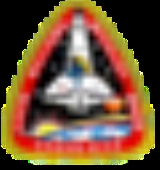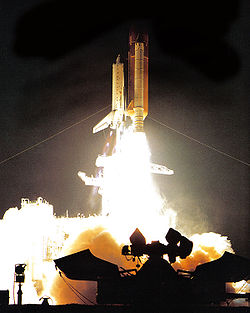
STS-33
Encyclopedia
Crew notes
S. David GriggsS. David Griggs
Stanley David Griggs was a United States Navy officer and a NASA astronaut. He is credited with conducting the first unscheduled extra-vehicular activity of the space program during Space Shuttle mission STS-51-D...
, the originally scheduled pilot for STS-33, died in a plane crash in June 1989, five months prior to the scheduled launch, and was replaced by John E. Blaha
John E. Blaha
John Elmer Blaha is an engineer, retired United States Air Force Colonel and a former NASA astronaut. He is a veteran of six Space Shuttle missions and a stay on the Mir space station....
.
Mission parameters
- MassMassMass can be defined as a quantitive measure of the resistance an object has to change in its velocity.In physics, mass commonly refers to any of the following three properties of matter, which have been shown experimentally to be equivalent:...
:- Payload: Magnum ELINT satellite ~ 3000 kilograms (6,613.9 lb)
- Booster: IUS upper stage ~ 18000 kilograms (39,683.2 lb)
- PerigeePerigeePerigee is the point at which an object makes its closest approach to the Earth.. Often the term is used in a broader sense to define the point in an orbit where the orbiting body is closest to the body it orbits. The opposite is the apogee, the farthest or highest point.The Greek prefix "peri"...
: 519 kilometres (322.5 mi) - Apogee: 519 kilometres (322.5 mi)
- InclinationInclinationInclination in general is the angle between a reference plane and another plane or axis of direction.-Orbits:The inclination is one of the six orbital parameters describing the shape and orientation of a celestial orbit...
: 28.5° - PeriodOrbital periodThe orbital period is the time taken for a given object to make one complete orbit about another object.When mentioned without further qualification in astronomy this refers to the sidereal period of an astronomical object, which is calculated with respect to the stars.There are several kinds of...
: 88.7 min
Mission background
STS-33 was the original designation for the mission that became STS-51-LSTS-51-L
STS-51-L was the twenty-fifth flight of the American Space Shuttle program, which marked the first time an ordinary civilian, schoolteacher Christa McAuliffe, had flown aboard the Space Shuttle. The mission used Space Shuttle Challenger, which lifted off from the Launch Complex 39-B on 28 January...
, the disastrous final flight
Space Shuttle Challenger disaster
The Space Shuttle Challenger disaster occurred on January 28, 1986, when Space Shuttle Challenger broke apart 73 seconds into its flight, leading to the deaths of its seven crew members. The spacecraft disintegrated over the Atlantic Ocean, off the coast of central Florida at 11:38 am EST...
of Space Shuttle Challenger
Space Shuttle Challenger
Space Shuttle Challenger was NASA's second Space Shuttle orbiter to be put into service, Columbia having been the first. The shuttle was built by Rockwell International's Space Transportation Systems Division in Downey, California...
. After Challenger
STS-26
STS-26 was the 26th NASA Space Shuttle mission and the seventh flight of the Discovery orbiter. The mission launched from Kennedy Space Center, Florida, on 29 September 1988, and landed four days later on 3 October. STS-26 was declared the "Return to Flight" mission, being the first mission after...
, which was the 26th shuttle mission and the first to fly after the disaster.
S. David Griggs
S. David Griggs
Stanley David Griggs was a United States Navy officer and a NASA astronaut. He is credited with conducting the first unscheduled extra-vehicular activity of the space program during Space Shuttle mission STS-51-D...
, a veteran of STS 51-D, was to have been the pilot of this mission. He was killed in the crash of a vintage WWII aircraft in June 1989 while training to serve as pilot on STS-33, and is commemorated on the mission insignia with a single gold star on the blue field. He was replaced by John Blaha. Sonny Carter
Sonny Carter
Manley Lanier "Sonny" Carter, Jr. was an American physician, professional soccer player, naval officer, and NASA astronaut who flew on STS-33.-Early life:...
, a Mission Specialist on this flight, was killed in a commercial plane crash on 5 April 1991 while training to fly on STS-42
STS-42
STS-42 was a Space Shuttle Discovery mission with the Spacelab module. Liftoff which was originally scheduled for 8:45 EST 22 January 1992, but the launch was delayed due to weather constraints. Discovery successfully lifted off an hour later at 9:52 EST . The main goal of the mission was to study...
.
Mission summary
STS-33 was originally scheduled to launch on 20 November, but was delayed because of problems with the integrated electronics assemblies which controlled the ignition and separation of the shuttle's solid rocket boosterSolid rocket booster
Solid rocket boosters or Solid Rocket Motors, SRM, are used to provide thrust in spacecraft launches from the launchpad up to burnout of the SRBs. Many launch vehicles include SRBs, including the Ariane 5, Atlas V , and the NASA Space Shuttle...
s. STS-33 was the third night launch of the Space Shuttle program, and the first since shuttle flights resumed in 1988 following the Challenger disaster of 1986.

International Designator
The International Designator, also known as COSPAR designation, and in the United States as NSSDC ID, is an international naming convention for satellites...
1989-090B). According to Aviation Week, this was a secret Magnum
Magnum (satellite)
Magnum is the code name for a class of SIGINT spy satellites reportedly operated by the National Reconnaissance Office for the United States Central Intelligence Agency...
ELINT (ELectronic INTtelligence) satellite headed for geosynchronous orbit
Geosynchronous orbit
A geosynchronous orbit is an orbit around the Earth with an orbital period that matches the Earth's sidereal rotation period...
, similar to that launched by STS-51-C
STS-51-C
STS-51-C was the 15th flight of NASA's Space Shuttle program, and the third flight of Space Shuttle Discovery. It was also the first shuttle mission to deploy a dedicated United States Department of Defense payload, and as such many mission details remain classified...
in 1985, making this mission essentially a duplicate of that earlier mission. According to Jim Slade of ABC News
ABC News
ABC News is the news gathering and broadcasting division of American broadcast television network ABC, a subsidiary of The Walt Disney Company...
, the satellite was intended to eavesdrop on military and diplomatic communications from the Soviet Union
Soviet Union
The Soviet Union , officially the Union of Soviet Socialist Republics , was a constitutionally socialist state that existed in Eurasia between 1922 and 1991....
, China
People's Republic of China
China , officially the People's Republic of China , is the most populous country in the world, with over 1.3 billion citizens. Located in East Asia, the country covers approximately 9.6 million square kilometres...
, and other communist states. The satellite replaced the one launched by STS-51-C, which was running out of the maneuvering fuel required for keeping its station over the Indian Ocean
Indian Ocean
The Indian Ocean is the third largest of the world's oceanic divisions, covering approximately 20% of the water on the Earth's surface. It is bounded on the north by the Indian Subcontinent and Arabian Peninsula ; on the west by eastern Africa; on the east by Indochina, the Sunda Islands, and...
.
Aviation Week claimed that the shuttle initially entered a 204 kilometres (126.8 mi) x 519 kilometres (322.5 mi) orbit at an inclination of 28.45 degrees to the equator
Equator
An equator is the intersection of a sphere's surface with the plane perpendicular to the sphere's axis of rotation and containing the sphere's center of mass....
. It then executed three Orbital Manoeuvering System (OMS) burns, the last on its fourth orbit. The first burn was to circularize the orbit at 519 kilometres (322.5 mi).
The satellite was deployed on the 7th orbit, and ignited its Inertial Upper Stage
Inertial Upper Stage
The Inertial Upper Stage , originally known as the Interim Upper Stage, is a two-stage solid-fueled booster rocket developed by the U.S...
(IUS) booster at the ascending node of the 8th orbit, successfully placing it in a geosynchronous transfer orbit. This was the 8th IUS launched aboard the shuttle, and the seventh successfully deployed.
STS-33 was observed by the 1.6m telescope of the US Air Force Maui Optical Station (AMOS) during five passes over Hawaii
Hawaii
Hawaii is the newest of the 50 U.S. states , and is the only U.S. state made up entirely of islands. It is the northernmost island group in Polynesia, occupying most of an archipelago in the central Pacific Ocean, southwest of the continental United States, southeast of Japan, and northeast of...
. Spectrographic and infrared images of the shuttle obtained with the Enhanced Longwave Spectral Imager (ELSI) were aimed at studying the interactions between gases released by the shuttle's primary reaction control system and residual atmospheric oxygen and nitrogen species in orbit.
The landing was initially scheduled for 26 November, but was postponed for a day because of strong winds at the landing site. Discovery landed at Edwards Air Force Base
Edwards Air Force Base
Edwards Air Force Base is a United States Air Force base located on the border of Kern County, Los Angeles County, and San Bernardino County, California, in the Antelope Valley. It is southwest of the central business district of North Edwards, California and due east of Rosamond.It is named in...
, California
California
California is a state located on the West Coast of the United States. It is by far the most populous U.S. state, and the third-largest by land area...
, on 27 November 1989 at 7:30 pm EST, after a mission duration of 5 days and 6 minutes.
See also
- SpaceflightSpaceflightSpaceflight is the act of travelling into or through outer space. Spaceflight can occur with spacecraft which may, or may not, have humans on board. Examples of human spaceflight include the Russian Soyuz program, the U.S. Space shuttle program, as well as the ongoing International Space Station...
- Space Shuttle programSpace Shuttle programNASA's Space Shuttle program, officially called Space Transportation System , was the United States government's manned launch vehicle program from 1981 to 2011...
- List of space shuttle missions
- List of human spaceflights chronologically

